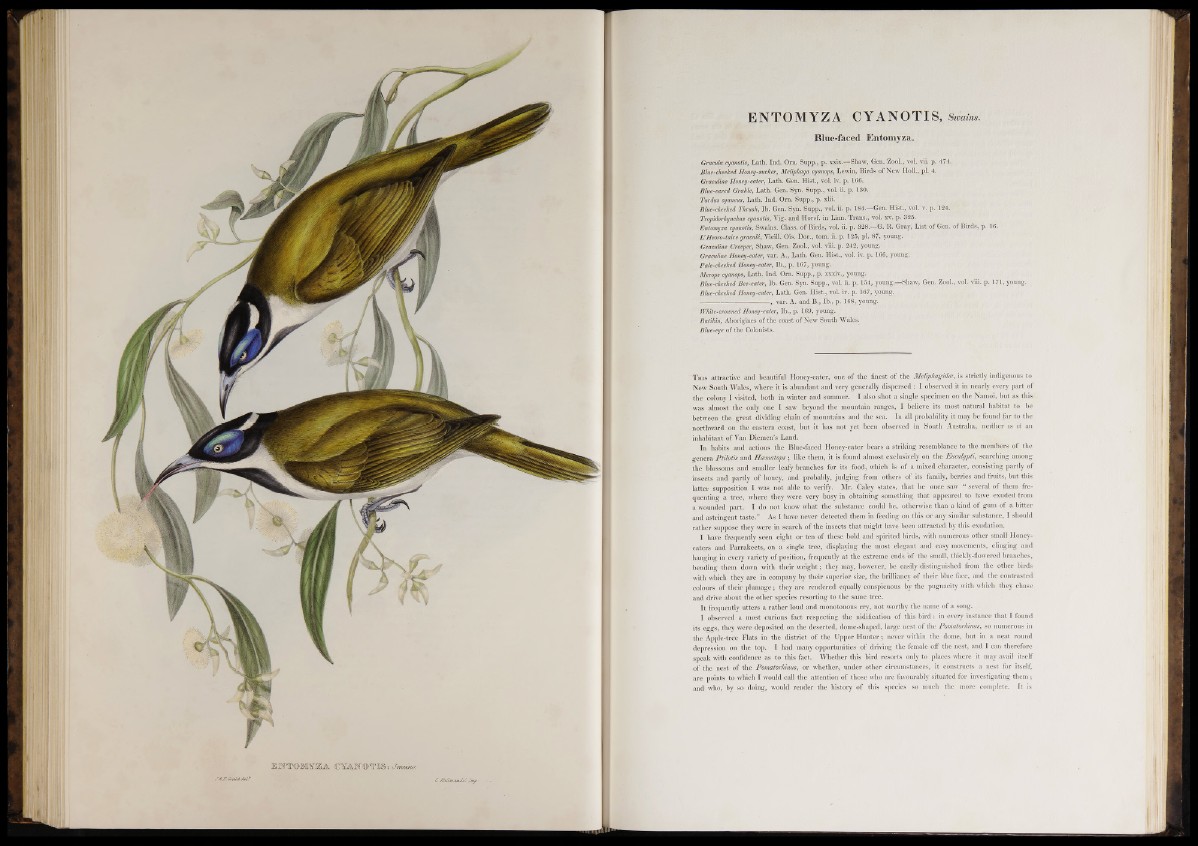
EMTOMY25A CYAKOTKSs Jmuna.-
C. fflilim ajidt l Imp:
ENTOMYZA CYANOTIS, Swains.
Blue-faced Entomyza.
Gracula cyanotis, Lath. Ind. Om. Supp., p. xxix.—Shaw, Gen. Zool., vol. vii. p. 474.
Blue-cheeked Honey-sucker, Meliphaga cyanops, Lewin, Birds of New Holl., pi. 4.
Graculine Honey-eater, Lath. Gen. Hist., vol. iv. p. 166.
Blue-eared Grakle, Lath. Gen. Syn. Supp., vol. ii. p. 130.
Turdus cyaneus, Lath. Ind. Om. Supp., p. xlii.
Blue-cheeked Thrush, lb. Gen. Syn: Supp., vol. ii. p. 184.—Gen. Hist., vol. v. p. 124.
Tropidorhynchus cyanotis, Vig. and Horsf. in Linn. Trans., vol. xv. p. 325.
Entomyza cyanotis, Swains. Class, of Birds, vol. ii. p. 328.—G. R. Gray, List of Gen. of Birds, p. 16.
VHeoro-taire gracuU, Vieill. Ois. Dor., tom. ii. p. 125, pi. 87, young.
Graculine Creeper, Shaw, Gen. Zool., vol. via. p. 242, young.
Graculine Honey-eater, var. A., Lath. Gen. Hist., vol. iv. p. 166, young,
Pale-cheeked Honey-eater, lb., p. 167, young.
Merops cyanops, Lath. Ind. Om. Supp., p. xxxiv., young.
Blue-cheeked Bee-eater, lb. Gen. Syn. Supp., vol. ii, p. 154, young.—Shaw, Gen. Zool., vol. viii. p. 171, young.
Blue-cheeked Honey-eater, Lath. Gen. Hist., vol. iv. p. 167, young.
------------------------------- , var. A. and B., Ib., p. 168, young.
White-crowned Honey-eater, Ib., p. 169, young.
Batikin, Aborigines of the coast of New South Wales.
Blue-eye of the Colonists. .
T h is attractive and beautiful Honey-eater, one of the finest of the MeliphagidtB, is strictly indigenous to
New South Wales, where it is abundant and very generally dispersed: I observed it in nearly every part of
the colony I visited, both in winter and summer. I also shot a single specimen on the Namoi, but as this
was almost the only one I saw beyond the mountain ranges, I believe its most natural habitat to be
between the great dividing chain of mountains and the sea. In all probability it may be found far to the
northward on the eastern coast, but it has not yet been observed in South Australia, neither is it an
inhabitant of Van Diemen’s Land.
In habits and actions the Blue-faced Honey-eater bears a striking resemblance to the members of the
genera Ptilotis and Hcematops; like them, it is found almost exclusively on the Eucalypti, searching among
the blossoms and smaller leafy branches for its food, which is of a mixed character, consisting partly of
insects and partly of honey, and probably, judging from others of its family, berries and fruits, but this
latter supposition I was not able to verify. Mr. Caley states, that he once saw “ several o f them frequenting
a tree, where they were very busy in obtaining something that appeared to have exuded from
a wounded part. I do not know what the substance could be, otherwise than a kind of gum of a bitter
and astringent taste.” As I have never detected them in feeding on this or any similar substance, I should
rather suppose they were in search of the insects that might have been attracted by this exudation.
I have frequently seen eight or ten of these bold and spirited birds, with numerous other small Honey-
eaters and Parrakeets, on a single tree, displaying the most elegant and easy movements, clinging and
hanging in every variety of position, frequently at the extreme ends of the small, thickly-flowered branches,
bending them down with their weight; they may, however, be easily distinguished from the other birds
with which they are in company by their superior size, the brilliancy o f their blue face, and the contrasted
colours of their plumage; they are rendered equally conspicuous by the pugnacity with which they chase
and drive about the other species resorting to the same tree.
It frequently utters a rather loud and monotonous cry, not worthy the name of a song.
I observed a most curious fact respecting the nidification o f this bird : in every instance that I found
its ego-s, they were deposited on the deserted, dome-shaped, large nest of the Pomatorhinus, so numerous in
the Apple-tree Flats in the district o f the Upper Hunter; never within the dome, but in a neat round
depression on the top. I had many opportunities of driving the female off the nest, and I can therefore
speak with confidence as to this fact. Whether this bird resorts only to places where it may avail itself
of the nest of the Pomatorhinus, or whether, under other circumstances, it constructs a nest for itself,
are points to which I would call the attention of those who are favourably situated for investigating them;
and who, by so doing, would render the history o f this species so much the more complete. It is